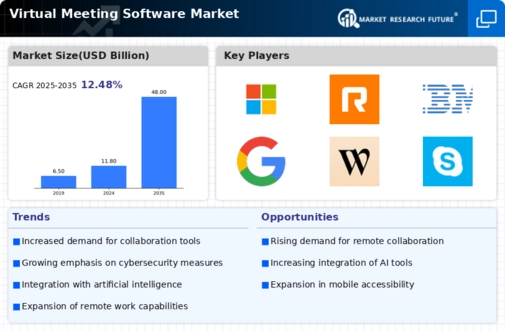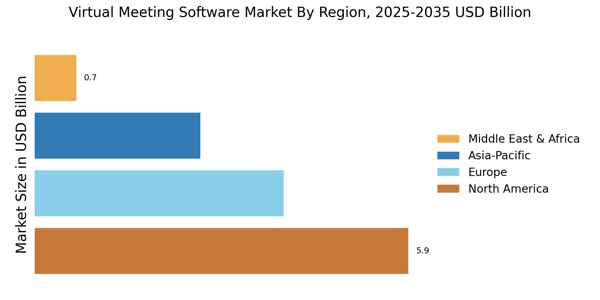Expansion of Mobile Accessibility
The expansion of mobile accessibility is a key driver in the Virtual Meeting Software Market. With the proliferation of smartphones and tablets, users increasingly expect to participate in meetings from any location. This trend is reflected in market data, which shows that mobile-compatible virtual meeting solutions are gaining popularity among businesses. Companies are recognizing the importance of providing employees with the flexibility to join meetings on-the-go, leading to enhanced productivity and engagement. As mobile technology continues to advance, the demand for virtual meeting software that offers seamless mobile experiences is likely to grow. Consequently, the Virtual Meeting Software Market is adapting to meet these needs, ensuring that users can connect and collaborate effectively, regardless of their device.
Growing Emphasis on Security Features
In the Virtual Meeting Software Market, there is an increasing emphasis on security features to protect sensitive information. As organizations conduct more meetings online, the risk of data breaches and unauthorized access becomes a pressing concern. Recent statistics indicate that nearly 70% of businesses prioritize security when selecting virtual meeting solutions. This trend is prompting software providers to enhance their security protocols, including end-to-end encryption and multi-factor authentication. The demand for secure virtual meeting platforms is likely to drive innovation within the industry, as companies seek to safeguard their communications. As a result, the Virtual Meeting Software Market is expected to witness growth in solutions that prioritize security, ensuring that organizations can conduct meetings with confidence.
Integration of Artificial Intelligence
The integration of artificial intelligence (AI) into the Virtual Meeting Software Market is transforming how meetings are conducted. AI technologies enhance user experience by providing features such as real-time transcription, automated scheduling, and intelligent meeting insights. These advancements not only streamline the meeting process but also improve overall efficiency. Market data suggests that AI-driven solutions are gaining traction, with a projected increase in adoption rates among businesses seeking to optimize their virtual interactions. The incorporation of AI capabilities allows organizations to analyze meeting data, identify trends, and make informed decisions. Consequently, the Virtual Meeting Software Market is evolving, as companies leverage AI to enhance productivity and engagement during virtual meetings.
Rising Demand for Remote Collaboration
The Virtual Meeting Software Market experiences a notable surge in demand for remote collaboration tools. As organizations increasingly adopt flexible work arrangements, the need for effective communication solutions becomes paramount. According to recent data, the market is projected to grow at a compound annual growth rate of approximately 12% over the next five years. This growth is driven by the necessity for teams to collaborate seamlessly, regardless of geographical barriers. Companies are investing in virtual meeting software to enhance productivity and maintain connectivity among employees. The rise of remote work culture has led to a significant increase in the adoption of these tools, indicating a shift in how businesses operate. As a result, the Virtual Meeting Software Market is likely to witness continued expansion as organizations prioritize collaboration and communication.
Increased Focus on Integration with Other Tools
The Virtual Meeting Software Market is witnessing an increased focus on integration with other business tools. Organizations are seeking solutions that can seamlessly connect with project management, customer relationship management, and other software applications. This trend is driven by the desire for streamlined workflows and enhanced productivity. Market analysis indicates that companies are more likely to adopt virtual meeting solutions that offer robust integration capabilities. By enabling users to access multiple tools within a single platform, these integrations facilitate smoother communication and collaboration. As a result, the Virtual Meeting Software Market is evolving to provide solutions that cater to the interconnected needs of modern businesses, fostering a more efficient working environment.


















Leave a Comment